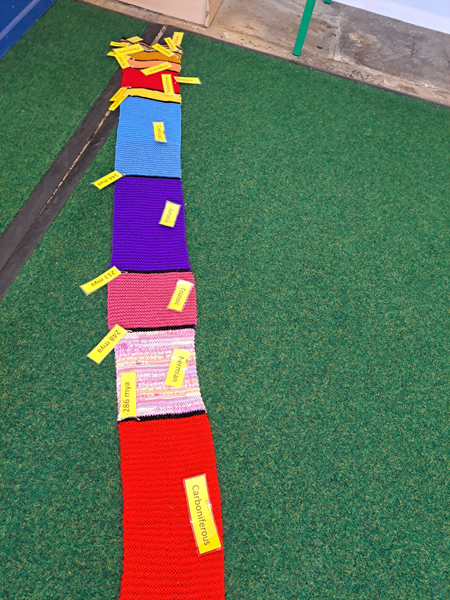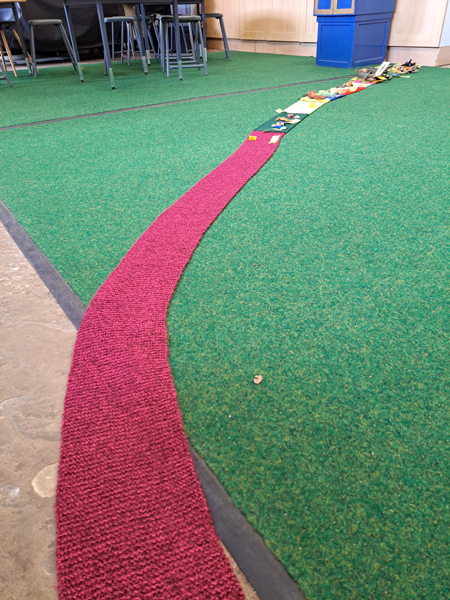It can be difficult to visualise the immensely long geological time scale and to demonstrate what lifeforms developed along the way, so, why not knit one and use prehistoric animal models to illustrate key moments in the history of life on Earth.
That’s exactly what Sue Mallender, Learning Programmes Science Officer, (Nottingham City Museums) and the Learning and Engagement team did – creating a colourful and striking depiction of the evolution of life on Earth.
Picture credit: Sue Mallender
Visualising Geological Time
In order to study the history of life, scientists need to locate important evolutionary events such as the development of animals with exoskeletons and the evolution of vertebrates within the geological time scale. Planet Earth was formed around 4.57 billion years ago. Geologists have divided the history of our planet into time intervals of varying duration. This time scale was devised in the 19th century, (although amendments to it and revisions continue to be made). The boundaries between the time intervals mark notable events such as dramatic changes in the type of fossils found in strata.
This remarkable knitted timescale provides a novel and very innovative way of demonstrating this fundamental aspect of geology.

Demonstrating deep geological time in knitted form. The geological time scale knitted. Picture credit: Sue Mallender.
Picture credit: Sue Mallender
This colourful visualisation of the age of our planet was created by dedicated knitter Helen Crowfoot.
The “Slow Burning Fuse” to Complex Life
The long interval of time from the origin of the Earth to the start of the Cambrian is referred to as the Cryptozoic Eon (meaning hidden life). This enormous time interval is also referred to as the Precambrian. Its length in comparison to the Phanerozoic Eon (visible life) – the time interval to the present day, is dramatically demonstrated in the knitted time scale by the burgundy-coloured strip.
Some palaeontologists have described the Cryptozoic Eon as the “slow burning fuse to complex life.”

A novel way of demonstrating the Cryptozoic Eon, informally known as the Precambrian – the immensely long period of time before complex life evolved on Earth. Picture credit: Sue Mallender
Picture credit: Sue Mallender
Cambrian Creatures
A spokesperson from Everything Dinosaur commented that they had been contacted about this innovative project and ask to recommend prehistoric animal models that could be placed along the time scale to depict the sort of creatures that evolved during the main geological periods.
The Everything Dinosaur spokesperson explained:
“We started with the Cambrian, suggesting some figures that could represent some of the first, large complex animals and then worked forwards from there recommending various models that could be used to populate the knitted time scale.”
Picture credit: Sue Mallender
To view the various toobs (tubes) of prehistoric animal models available from Everything Dinosaur: Wild Safari Prehistoric World Models.
The spokesperson added:
“What a super idea! This is a fantastic way to visualise geological time and we congratulate Sue and the Learning and Engagement team for such an innovative and creative way of demonstrating how life on our planet has changed over millions of years.”
The award-winning Everything Dinosaur website: Dinosaur Toys.








Leave A Comment